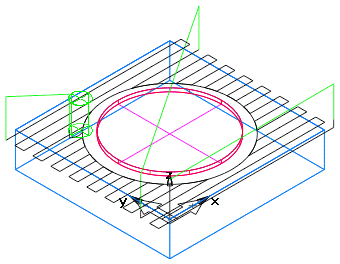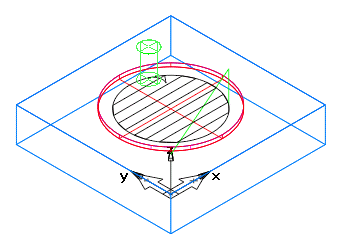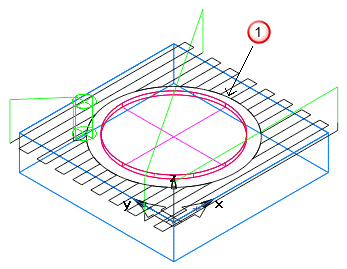For a Boss feature, the toolpaths are laid in parallel lines across the stock and clipped against the boundaries of the Boss.

The starting point is one of the four corners of the stock. You can change the angle of the toolpaths, but the neighboring toolpaths are always parallel.

For a Pocket feature, the parallel toolpaths are laid inside the Pocket boundary.

After the parallel paths, a clean-up pass is then performed around the boundaries of Bosses, Pockets, and Pocket islands.
The Zigzag roughing pass has two phases, the parallel roughing phase and the boundary clean-up phase. The clean-up phase, marked
 , cleans up the boundaries of the feature to ensure a uniform finish allowance:
, cleans up the boundaries of the feature to ensure a uniform finish allowance:

The tree view for the feature only shows a single feature, so the clean-up phase uses the same feed and speed values as the roughing pass. The number of clean-up passes is determined by the Cleanup passes attribute. If Cleanup passes is set to 0, the clean-up pass is not performed. If set to 1, a single pass is performed along the boundaries of the roughing region:
|
|
|
The roughing region is determined by offsetting the boundaries of the feature by the Finish allowance.
If set to a number larger than 1, multiple clean-up passes are performed. The default spacing of these passes is controlled by the Cleanup stepover attribute. To more finely control the spacing of multiple clean-up passes, set the Cleanup stepover attribute.
The ramping onto the clean-up pass is controlled by the Ramp diameter attribute.
The direction of the Zigzag path is controlled by the relationship between the Zigzag angle and the Climb mill attributes.
If the Bi-directional rough or the Reorder attribute is selected, the toolpath is reordered so that it completes one region before moving on to the next.
When roughing a Boss with the Zigzag method, the amount that the tool overlaps the stock boundary is controlled by the Finish allowance.
The Zigzag technique applies to a finishing pass only if the bottom of the feature is being finished. In this case, it behaves just like a single roughing pass.

 -
Finish allowance
-
Finish allowance